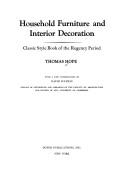| Listing 1 - 10 of 39 | << page >> |
Sort by
|
Book
ISBN: 9780486200217 Year: 2016 Publisher: New York Dover Publications
Abstract | Keywords | Export | Availability | Bookmark
 Loading...
Loading...Choose an application
- Reference Manager
- EndNote
- RefWorks (Direct export to RefWorks)
From headdresses to sandals, from warrior's armor to priestess's robes, the authentic costumes of people from all walks of life in the Roman and Greek civilizations are here pictured comprehensively and clearly. Three hundred finely drawn, detailed engravings (containing over 700 illustrations) show just what was worn by the poets, philosophers, priests and priestesses, peasants, Bacchanalians, emperors, generals, Amazons, and virgins of a bygone age.Carefully copied from ancient vases and statuary by Thomas Hope (1770-1831), a British collector and designer, these engravings combine an unusual clarity of style with unquestioned authenticity. Their range, too, is unusually great, for besides the many plates on the costumes of the Greeks and Romans, there are representative illustrations of the typical dress of such other civilizations as the Phrygian, Egyptian, Parthian, Etruscan, and Persian.In addition, scores of engravings are devoted to such now-forgotten objects as ancient musical instruments (the lyre, double flute, pipes of Pan, etc.), Bacchanalian implements, articles of furniture, women's trinkets and jewelry, sarcophagi, altars, and other adjuncts to ancient life.http://store.doverpublications.com/0486200213.html
Geschiedenis --- Kostuumkunde --- Klederdrachten --- Oudheid --- Romeinse Rijk --- Hellas --- Klederdracht --- Geneeskunde --- Techniek (wetenschap) --- Hellenisme --- Griekenland --- Atlas --- Museum --- Filosofie --- Film --- Literatuur --- Muziek --- Schilderkunst --- Tekenkunst --- Vlaanderen --- Vlaams --- Emigratie --- Vrouw
Book
ISBN: 1107109809 1108068421 Year: 2014 Publisher: Cambridge : Cambridge University Press,
Abstract | Keywords | Export | Availability | Bookmark
 Loading...
Loading...Choose an application
- Reference Manager
- EndNote
- RefWorks (Direct export to RefWorks)
With a fondness for classical antiquities and neoclassical design, the connoisseur Thomas Hope (1769-1831) sought to influence Georgian taste by promoting informed interior decoration, displaying his own considerable art collection, and writing with insight on aesthetic topics. This two-volume work, originally published posthumously in 1835, traces the evolution of Western architecture since antiquity. Hope was a keen traveller, and the examples he cites are drawn from buildings that he studied on journeys through Europe and beyond, notably in those countries bordering the Mediterranean. Volume 2 contains the precise line drawings that accompanied the first edition, showcasing many western European and ecclesiastical buildings and details. The work's analytical index, which appeared in 1836, is illustrated with wood engravings of features mentioned in the text and has been incorporated in this reissue.
Architecture --- History.
Book
ISBN: 1107109795 1108068413 Year: 2014 Publisher: Cambridge : Cambridge University Press,
Abstract | Keywords | Export | Availability | Bookmark
 Loading...
Loading...Choose an application
- Reference Manager
- EndNote
- RefWorks (Direct export to RefWorks)
With a fondness for classical antiquities and neoclassical design, the connoisseur Thomas Hope (1769-1831) sought to influence Georgian taste by promoting informed interior decoration, displaying his own considerable art collection, and writing with insight on aesthetic topics. This two-volume work, originally published posthumously in 1835, traces the evolution of Western architecture since antiquity. Hope was a keen traveller, and the examples he cites are drawn from buildings that he studied on journeys through Europe and beyond, notably in those countries bordering the Mediterranean. Reissued here in the third edition that appeared in 1840, Volume 1 examines how religions, climates, landscapes and prevailing mores shaped the architectural preferences of civilisations from ancient Egypt to the Gothic revival, as well as how different cultures adapted foreign or ancient architectural innovations for their own ends.
Architecture --- History.
Book
ISBN: 0854582506 Year: 1970 Publisher: Londen : Alec Tiranti,
Abstract | Keywords | Export | Availability | Bookmark
 Loading...
Loading...Choose an application
- Reference Manager
- EndNote
- RefWorks (Direct export to RefWorks)

ISBN: 0486217108 Year: 1971 Publisher: New York : Dover Publications,
Abstract | Keywords | Export | Availability | Bookmark
 Loading...
Loading...Choose an application
- Reference Manager
- EndNote
- RefWorks (Direct export to RefWorks)
Decoration and ornament --- Furniture --- Furniture, Regency --- Regency style. --- History
Book
Year: 1826 Publisher: Bruxelles: G. P. vanden Burggraaff, Pierre-Joseph De Mat,
Abstract | Keywords | Export | Availability | Bookmark
 Loading...
Loading...Choose an application
- Reference Manager
- EndNote
- RefWorks (Direct export to RefWorks)
Book
Year: 2014 Publisher: Cambridge Cambridge University Press
Abstract | Keywords | Export | Availability | Bookmark
 Loading...
Loading...Choose an application
- Reference Manager
- EndNote
- RefWorks (Direct export to RefWorks)
Architecture --- History --- architecture [discipline] --- history [discipline] --- geschiedenis --- architectuur
Digital
Year: 1831 Publisher: Paris Baudry's Foreign Library
Abstract | Keywords | Export | Availability | Bookmark
 Loading...
Loading...Choose an application
- Reference Manager
- EndNote
- RefWorks (Direct export to RefWorks)
Book
Year: 1852 Publisher: Bruxelles Méline, Cans et Cé, libraires-éditeurs
Abstract | Keywords | Export | Availability | Bookmark
 Loading...
Loading...Choose an application
- Reference Manager
- EndNote
- RefWorks (Direct export to RefWorks)
Book
Year: 1839 Publisher: Bruxelles : Meline, Cans et compagnie,
Abstract | Keywords | Export | Availability | Bookmark
 Loading...
Loading...Choose an application
- Reference Manager
- EndNote
- RefWorks (Direct export to RefWorks)
Architecture --- Architecture --- History --- Histoire
| Listing 1 - 10 of 39 | << page >> |
Sort by
|

 Search
Search Feedback
Feedback About UniCat
About UniCat  Help
Help News
News